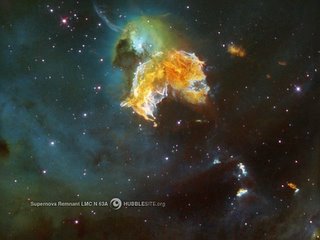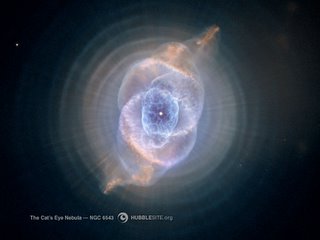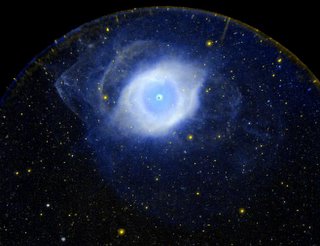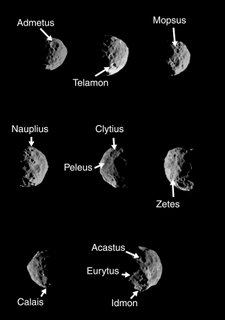Releases from NASA, HubbleSite, Spitzer, ESO, ESA, NASA’s Chandra X-ray Observatory, Royal Astronomical Society, Harvard-Smithsonian Center For Astrophysics, Max Planck Institute, Gemini Observatory, Subaru Telescope, W. M. Keck Observatory, JPL-Caltech, ICRAR, Webb Space Telescope, etc
Thursday, January 19, 2006
The Southern Ring Nebula (NGC 3132) - Courtesy Nasa/Hubble Heritage
 This planetary nebula, also known as the "Eight-Burst" Nebula because of its figure-8 appearance through amateur astronomer telescopes, is visible in the southern hemisphere. NGC 3132 is nearly half a light year in diameter and 2,000 light years away. Gases are moving away from the dying star at its center at a speed of nine miles per second (14.4 km/s).
This planetary nebula, also known as the "Eight-Burst" Nebula because of its figure-8 appearance through amateur astronomer telescopes, is visible in the southern hemisphere. NGC 3132 is nearly half a light year in diameter and 2,000 light years away. Gases are moving away from the dying star at its center at a speed of nine miles per second (14.4 km/s).The Ghost Head Nebula - NGC 2028 - Courtesy Nasa/Esa
 This nebula is one of a chain of star-forming regions lying south of the 30 Doradus nebula in the Large Magellanic Cloud. The red and blue light comes from regions of hydrogen gas heated by nearby stars. The green light comes from glowing oxygen, illuminated by the energy of a stellar wind. The white center shows a core of hot, massive stars.
This nebula is one of a chain of star-forming regions lying south of the 30 Doradus nebula in the Large Magellanic Cloud. The red and blue light comes from regions of hydrogen gas heated by nearby stars. The green light comes from glowing oxygen, illuminated by the energy of a stellar wind. The white center shows a core of hot, massive stars.
Boomerang Nebula
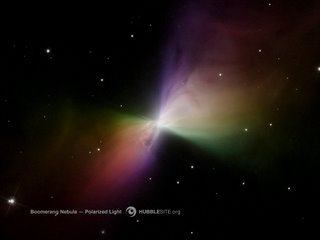 The Hubble Space Telescope has "caught" the Boomerang Nebula in these new images taken with the Advanced Camera for Surveys. This reflecting cloud of dust and gas has two nearly symmetric lobes (or cones) of matter that are being ejected from a central star. Over the last 1,500 years, nearly one and a half times the mass of our Sun has been lost by the central star of the Boomerang Nebula in an ejection process known as a bipolar outflow. The nebula's name is derived from its symmetric structure as seen from ground-based telescopes. Hubble's sharp view is able to resolve patterns and ripples in the nebula very close to the central star that are not visible from the ground.
The Hubble Space Telescope has "caught" the Boomerang Nebula in these new images taken with the Advanced Camera for Surveys. This reflecting cloud of dust and gas has two nearly symmetric lobes (or cones) of matter that are being ejected from a central star. Over the last 1,500 years, nearly one and a half times the mass of our Sun has been lost by the central star of the Boomerang Nebula in an ejection process known as a bipolar outflow. The nebula's name is derived from its symmetric structure as seen from ground-based telescopes. Hubble's sharp view is able to resolve patterns and ripples in the nebula very close to the central star that are not visible from the ground.Orion Nebula - Courtesy Nasa/Hubble Heritage
NASA's Hubble Space Telescope has captured one of the most detailed astronomical images in history. Released yesterday, the original of this Orion Nebula image is a mosaic of a billion pixels—nearly 5,000 times sharper than the 212,521-pixel version on this page.
Despite their stunning depiction of stars still forming in wombs of gas and dust (as well as thousands of heretofore unseen stars), these details aren't simply in the service of beauty.
Wednesday, January 11, 2006
Cartwheel Galaxy
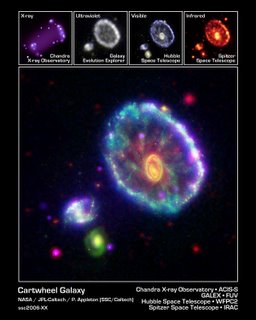 Image Left:
Image Left:Tuesday, January 03, 2006
Galaxy Pair NGC 3314
 This image from NASA's Hubble Space Telescope and its Wide Field Planetary Camera 2
This image from NASA's Hubble Space Telescope and its Wide Field Planetary Camera 2(WFPC2) shows the unique galaxy pair called NGC 3314. Through an extraordinary chance alignment, a face-0n spiral galaxy lies precisely
in front of another larger spiral. This line-up provides us with rare chance to visualize dark material within the front galaxy, seen only because it is silhouetted against the object behind it.




